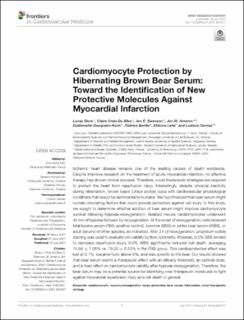Cardiomyocyte protection by hibernating brown bear serum: towards the identification of new protective molecules against myocardial infarction
Givre, Lucas; Da Silva, Claire Crola; Swenson, Jon; Arnemo, Jon Martin; Gauquelin-Koch, Guillemette; Bertile, Fabrice; Lefai, Etienne; Gomez, Ludovic
Peer reviewed, Journal article
Published version
Permanent lenke
https://hdl.handle.net/11250/2999552Utgivelsesdato
2021Metadata
Vis full innførselSamlinger
Sammendrag
Ischemic heart disease remains one of the leading causes of death worldwide. Despite intensive research on the treatment of acute myocardial infarction, no effective therapy has shown clinical success. Therefore, novel therapeutic strategies are required to protect the heart from reperfusion injury. Interestingly, despite physical inactivity during hibernation, brown bears (Ursus arctos) cope with cardiovascular physiological conditions that would be detrimental to humans. We hypothesized that bear serum might contain circulating factors that could provide protection against cell injury. In this study, we sought to determine whether addition of bear serum might improve cardiomyocyte survival following hypoxia–reoxygenation. Isolated mouse cardiomyocytes underwent 45 min of hypoxia followed by reoxygenation. At the onset of reoxygenation, cells received fetal bovine serum (FBS; positive control), summer (SBS) or winter bear serum (WBS), or adult serums of other species, as indicated. After 2 h of reoxygenation, propidium iodide staining was used to evaluate cell viability by flow cytometry. Whereas, 0.5% SBS tended to decrease reperfusion injury, 0.5% WBS significantly reduced cell death, averaging 74.04 ± 7.06% vs. 79.20 ± 6.53% in the FBS group. This cardioprotective effect was lost at 0.1%, became toxic above 5%, and was specific to the bear. Our results showed that bear serum exerts a therapeutic effect with an efficacy threshold, an optimal dose, and a toxic effect on cardiomyocyte viability after hypoxia–reoxygenation. Therefore, the bear serum may be a potential source for identifying new therapeutic molecules to fight against myocardial reperfusion injury and cell death in general.

